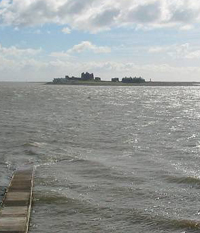|
Piel Island is a 52-acre stretch of shingle
beach and scrubland, topped by a ruined 14th-century castle managed by
English Heritage. Just offshore from Barrow in Furness it is a designanted
SSI and has a 17th century inn the Ship, current (2011) licensee and 'King'
of Piel is Steve Chattaway. The king is crowned in a carved out oak tree.The
landlord is known as 'The King of Piel', a title originating from the
time of Lambert Simnel and his attempt to usurp the English throne. In
1487 Lambert Simnel landed on the island, claiming to be earl of Warwick
and, therefore, the rightful king of England. Simnel’s mercenary
army subsequently marched on to London, only to be defeated by Henry VII
at the Battle of Stoke (see more details below) . His attempt on the throne
has been parodied ever since by crowning the pub’s landlord.
The Ship does bed and breakfast and there is a campsite and six weathered-stone
cottages kept as holiday homes by local families.
More information can be seen at www.pielisland.co.uk
Being separated from neighbouring Roa Island by the Piel Channel, the
island is accessible via a ferryboat which runs from Roa Island pier during
summer weekends. Piel Castle is managed by English Heritage and there
is free, unlimited access. The castle, located on the southeast tip of
Piel Island, is an impressive ruin made up largely of stones from the
beach. The three-storey keep affords spectacular views of the island although,
sadly, is no longer accessible to visitors, though campers may pitch a
tent in its shadows.
The island is a haven for wildlife with many different species of sea
bird to be found. Visitors should take care not to disturb nesting birds
while walking on the beach. A marsh pond in the centre of the island now
attracts many other types of bird.
The White Rose Power Grabbers
*A new book, the 'Last White Rose', gives
a fascinating view of how Cumberland was one of the hot beds of anti-Tudor
sentiment that almost brought the famous line of kings and queens to a
premature end.
The White Rose of the title referred to the string of Yorkist rivals to
Henry the Seventh and Eighth and how several times they came close to
toppling the Tudors. Henry the Seventh had a slender connection to the
Royal line when he defeated Richard the Third at Bosworth in 1485 and
for half a century the Yorkshire claim on the throne of England kept re-emerging.
The first bid to topple Henry VII was in 1487 when on June 4 the Yorkists,
including expensive German mercenaries and Irish footsoldiers, landed
at Foulney Island, near Barrow. They then landed troops at Furness Fell
where they were welcomed by Cumberland's Sir Thomas Broughton. (Lambert
Simnel and his supporters arrived from Dublin. Simnel was being passed
off as Edward VI, King of England by John de la Pole, Earl of Lincoln
in his attempt to regain the throne for the Yorkists.) From the Furness
landing areas they marched across the Pennines to York. But unfortunately
for the power bidders they got a less friendly welcome and the city authorities
did not dare defy King Henry and they refused to let the Yorkists in.
Landowners in the region did however give support and the army grew to
be 10,000 strong. But after a three hours battle near Nottingham the Irish
and German troops fled and Henry Tudor defeated this first White Rose
bid to destroy the Tudors.
The book goes on to chronicle how there was a huge groundswell of anger
in England when Henry VII abolished the monasteries. Monasteries such
as Furness, Calder and Lanercost Priory provided hospitals and alms houses
for the poor and were some of the few social services available at that
time. In 1536 there were still anti-Tudor activists in Cumberland who
took part in the mass uprising called the Pilgrimage of Grace.
Carlisle, Penrith and Kirkby Stephen were among towns across the North
where thousands armed themselves with billhooks and weapons in revolt
over the way Henry had destroyed and sold off the monastic lands to wealthy
lords and had increased the taxes on everyday life. The Pilgrimage rebellion
was divided into nine armies. But crafty negotiating by the outnumbered
Army Royal secured a truce and Henry promised all the rebels a pardon
with the exception of ten ringleaders. A year later Henry declared martial
law and ripped up any pardons and had a reign of terror across the North.
The book recalls how “men were strung up on trees in their own gardens,
priests dangled from steeples...some hangings took place without trial
to avoid any chance of acquittal. The King rejected all appeals and if
a jury found s defendant not guilty, he ordered a retrial.”
The Last White Rose by Desmond Seward is published by Constable in hardback
and also can be obtained via Cumbria Libraries. DS,
|
|
|
|

Pic credit :Stephen Dawson.
|
|

